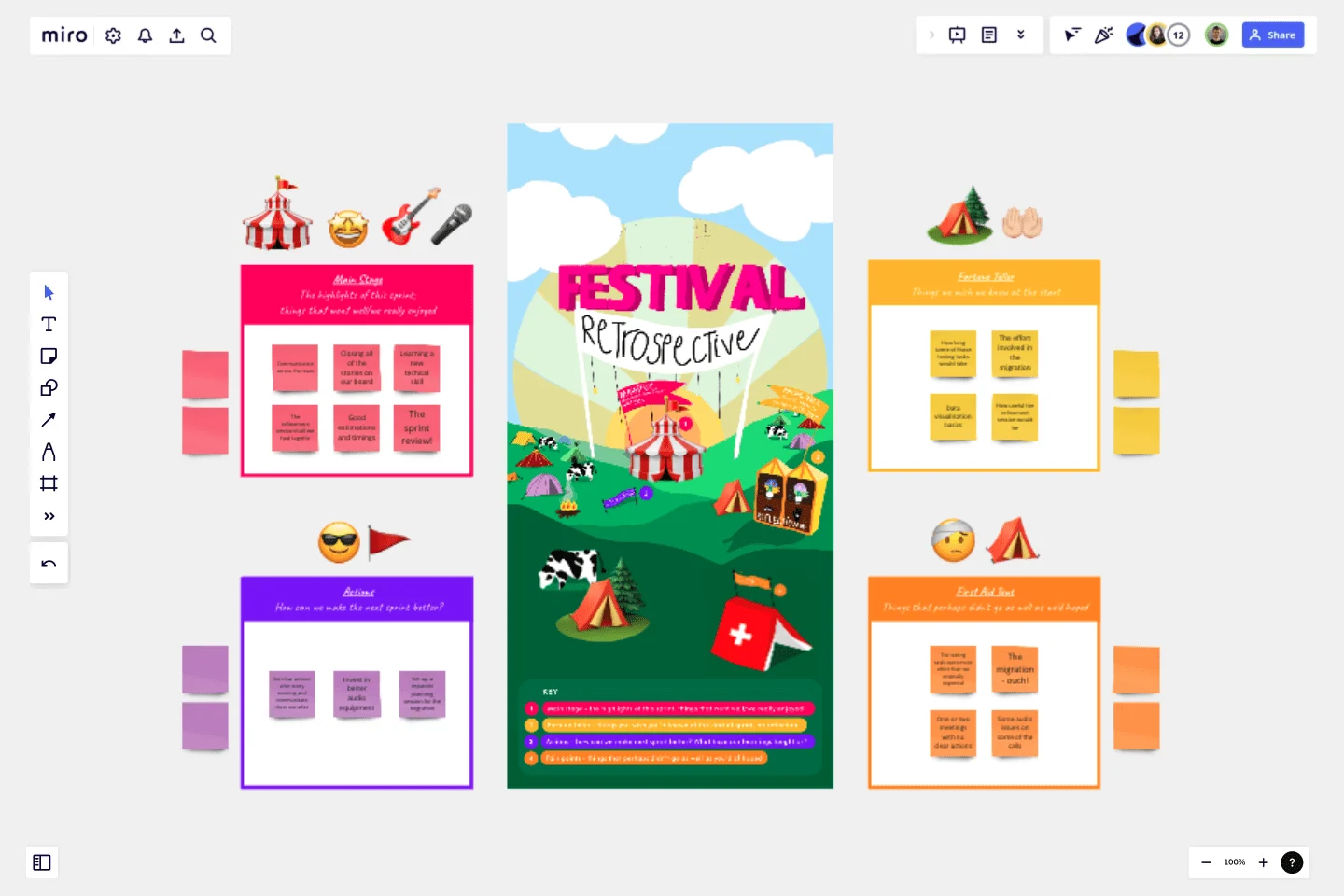Festival Retrospective
The festival themed retrospective has been designed using the metaphors and common areas of a festival for teams to share ideas and key themes
Trusted by 65M+ users and leading companies
The retrospective is broken up into four main areas:
The Main Stage - highlights of the sprint/iteration; things that went well and that the team enjoyed
Fortune Teller - things we wish we knew at the start
First Aid Tent - pain points; things that perhaps didn't go as well as we'd have hoped
Actions - how can we make the next sprint/iteration better?
Use the blank post-it templates available and some of the example post-its as a starter and work your way around the board from Main Stage, to Fortune Teller, to the First Aid Tent, where the pain points identified by the team help to drive conversation and insight into the final Actions section.
Enjoy!
Credit for the creative and design to some of the fantastic designers working at Dyson.
Get started with this template right now.
BPM
Works best for:
Diagramming
The BPM (Business Process Management) template is a visual tool for modeling, analyzing, and optimizing business processes. It provides a structured framework for documenting process flows, identifying bottlenecks, and improving efficiency. This template enables organizations to streamline operations, enhance productivity, and drive business performance. By promoting process transparency and agility, the BPM template empowers teams to achieve operational excellence and deliver value to stakeholders.
Product Hypothesis Canvas
Works best for:
Product Management, Planning
The Product Hypothesis Canvas template assists product teams in formulating and testing hypotheses effectively. By defining assumptions, success metrics, and validation experiments, this template guides teams through the hypothesis validation process. With sections for articulating problem statements, proposed solutions, and expected outcomes, it ensures that hypotheses are clear, testable, and aligned with strategic objectives. This template serves as a framework for hypothesis-driven product development, enabling teams to validate ideas and make data-informed decisions.
Taco Tuesday Retrospective
Works best for:
Agile Methodology, Retrospectives, Meetings
The Taco Tuesday Retrospective template offers a fun and informal approach to retrospectives, perfect for fostering team camaraderie. It provides elements for reflecting on past iterations over a casual taco-themed gathering. This template enables teams to relax, share insights, and brainstorm ideas in a laid-back atmosphere. By promoting social interaction and creativity, the Taco Tuesday Retrospective empowers teams to strengthen relationships, boost morale, and drive continuous improvement effectively.
Empathy Map for Educational Purposes
Works best for:
Product Management
Enhance your educational approach with the Empathy Map for Educational Purposes template. This tool helps educators understand students' perspectives, needs, and emotions. Use it to create a more empathetic and effective teaching strategy, ensuring that your educational content resonates with and supports your students. Ideal for teachers and educational planners aiming to improve student engagement and learning outcomes.
The Tiered Pricing Canvas - Product Plans
Works best for:
Product Management, Planning
The Tiered Pricing Canvas - Product Plans template helps product managers design tiered pricing strategies effectively. By mapping out pricing tiers, features, and value propositions, this template enables teams to optimize pricing models and maximize revenue. With sections for analyzing customer segments and competitive pricing, it supports data-driven pricing decisions. This template serves as a guide for crafting compelling pricing plans that align with customer needs and market dynamics, driving profitability and customer satisfaction.
8 Bit Hearts - A Retrospective
Works best for:
Agile Methodology, Retrospectives, Meetings
The 8 Bit Hearts - A Retrospective template offers a nostalgic and creative approach to retrospectives, using retro gaming elements to engage team members. It provides elements for reflecting on past experiences, celebrating achievements, and identifying areas for improvement. This template enables teams to foster a fun and collaborative atmosphere, promoting open communication and creative thinking. By combining nostalgia with reflection, the 8 Bit Hearts - A Retrospective empowers teams to build stronger bonds, boost morale, and drive continuous improvement effectively.
